- Home
- The challenging job of vets assessing hoof trimmers
The challenging job of vets assessing hoof trimmers
Owen Atkinson gives Mobility Mentor vets his tips on how to discuss correct trimming techniques on farm.
Vets tend to do very little trimming these days. Most is done by farmers themselves or by professional hoof trimmers. Some is a high standard, but much is not. Unfortunately, the trimming industry is poorly regulated, and there is no enforcement of the law which stipulates competency whether stockperson or contract foot trimmer.
Mobility Mentor vets may not be the people wielding the knife - or more frequently, the grinder - but vets do need to be able to confidently discuss correct trimming techniques, or adjustments to trimming techniques, particularly when trimming is likely to be contributing to lesions causing lameness. Unfortunately, our experience is that even trained trimmers can slip into bad habits. Usually, this involves removing too much horn in some way or other.
Whilst not covering all aspects of trimming assessment, this article will hopefully give you a few pointers to help you make a start.
Communicating with the team
Don’t underestimate the sensitivity and pride many trimmers and farmers have when it comes to their trimming, and how beliefs and old habits become deeply engrained. For many people it is easier to justify old habits which rather than to adjust behaviours. There is potential for some trimmers or farmers to take deep offense at challenge from a vet, even if well-meaning, particularly if you’re not trimming many feet yourself. In any discussion it can be helpful to start with the common goal – you’re trying to support effective trimming protocols to discover ways of improving foot health.
Toe length cut too short
We will begin with overall toe length. When toes are trimmed too short, it usually means the soles will be trimmed too thin as well. Toe length can be assessed at a herd level very easily on most farms during milking, at least for the hind feet, whilst cows stand on the parlour platform. First, be careful from which point you measure. If from the bottom of the perioplic horn (where the hard horn begins), this will be approximately 5-10mm shorter than if measuring from the actual coronary band, where the soft perioplic horn begins. The measurements given in the graph below are taken from the very top of the perioplic horn down to a sharp point at the toe.
A study of cadaver feet from dairy cows found that there is not a one-size-fits all. Graph 1 shows the percentage of those feet that would not allow for at least a 5mm sole thickness if trimmed to a given length.
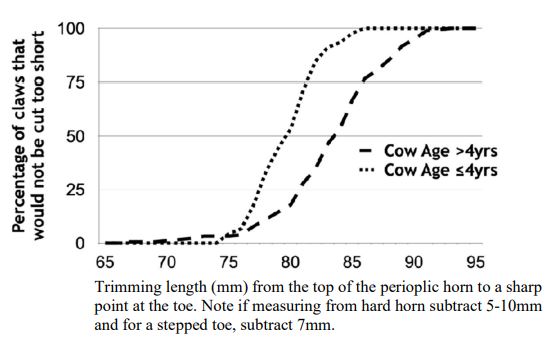 Owen Atkinson
Owen Atkinson
Graph 1: Theoretical trimming length (measured from top of the perioplic horn to a sharp point at the toe) vs percentage of cows which would be left with soles with an adequate thickness (at least 5mm).
In older cows (> 4 years old), around 50% of cows would have been trimmed too short at 85mm measured according to the researchers, yet this length would have been OK for the majority of younger cows. Meanwhile, 75mm (the length first described by Dr Toussaint Raven in the Dutch Five Step method in the 1970s) is too short for almost every cow in the modern UK dairy herd using these landmarks. However, do note this was using very different anatomical landmarks to those used by instructors delivering traditionally taught trimming methods.
Once you know where to measure from and to, next know how to do it. Because cows’ dorsal walls are generally not perfectly straight, it helps a lot to use a measuring tool which is shaped to accommodate this. This is illustrated in Figure 1.
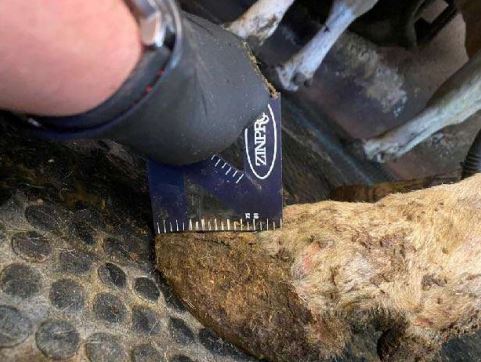 Owen Atkinson
Owen Atkinson
Figure 1: Using a Zinpro measuring tool to measure toe length in a standing cow.
If it is suspected that a trimmer is trimming too short, then lift a few recently trimmed feet and check more thoroughly (see Figure 2). The advantage then is that, as well as measuring toe length, the sole depth can be gauged by using thumb pressure and hoof testers. If the sole “gives” with thumb pressure, in particular in the toe region, it is too thin.
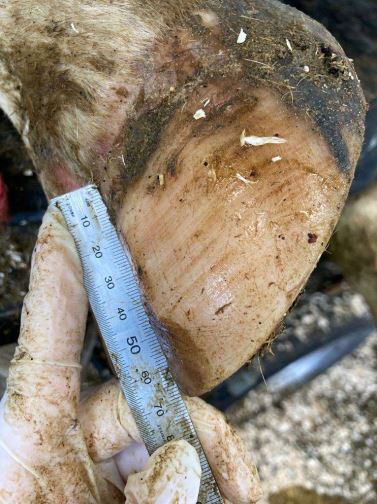 Owen Atkinson
Owen Atkinson
Figure 2: A toe which has been trimmed too short, at just 70mm with no step at the tip of the toe.
Over trimming of the sole
It is usually possible to see where the knife or grinder has been recently used. Assuming the toe length is correct, and there are no lesions at the toe, the region of the sole called the “toe triangle” should not be thinned at all - see Figure 3.
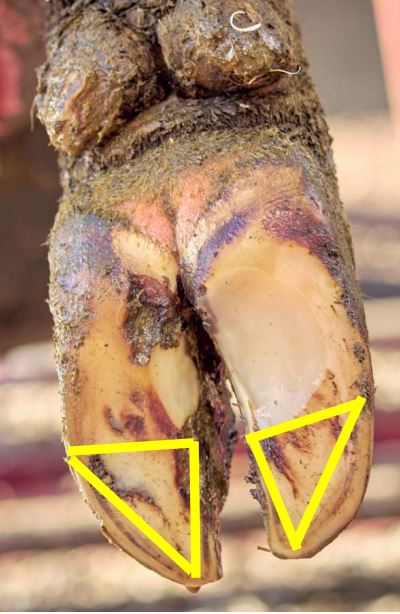 Owen Atkinson
Owen Atkinson
Figure 3 showing the toe triangle regions, delineated by the yellow lines. The area corresponds with the point where the white line disappears on the axial wall. Roughly speaking, it is the front third of the claw. Modelling of the sole should always be behind this area.
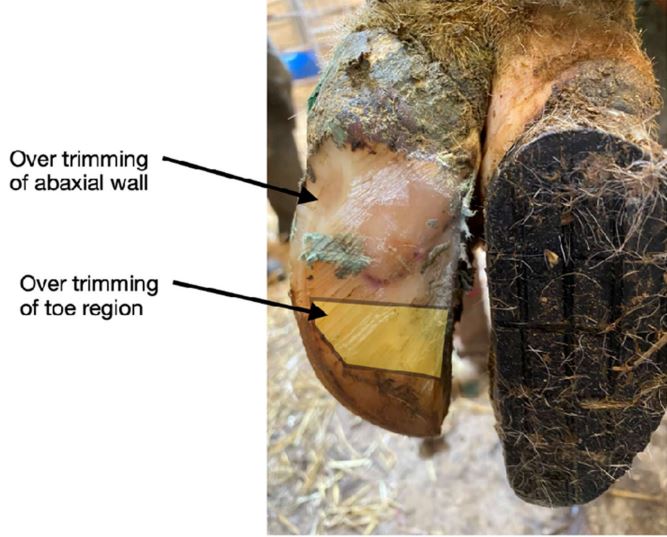 Owen Atkinson
Owen Atkinson
Figure 4 shows over trimming where the sole in the toe triangle region has been trimmed with a grinder (or cutting disc), as well as unnecessary removal of the abaxial wall and a complete lack of modelling.
Grinding of the wall
Excess removal (thinning) of the wall is almost always a fault involving a grinder, because it is difficult to do with a knife.
Never, never allow this fault to go unnoticed. It is oh-so-common for people to run a grinder or knife between the toes and thin the axial walls! In a misguided way they often say they are “tidying up” the hoof. The wall is what gives the hoof its strength and it should NOT be thinned.
Just as common, is grinding or “shaping” of the outer wall. If ever this is seen, immediately stop this person from trimming any cow until they have been properly trained or re-trained, because they will be doing immense damage to the cows they trim.
It is worth saying this again: THE WALL SHOULD NOT BE THINNED. This is true for the dorsal wall, the abaxial wall and the axial wall. The single exception is if it is part of a specific treatment of a white line lesion to help remove unattached horn where pus/infection has extended up the inside laminal surface of the wall.
Incorrect modelling
Modelling describes the removal of sole horn in the region of the usual pressure point beneath the pedal bone. This area is associated with most sole bruising and sole ulcers. Modelling should always be behind the toe triangle.
Traditionally, modelling would be towards the centre line of the claw, if an imaginary line bisected the claw lengthwise from toe to heel. This is illustrated in Figure 5a.
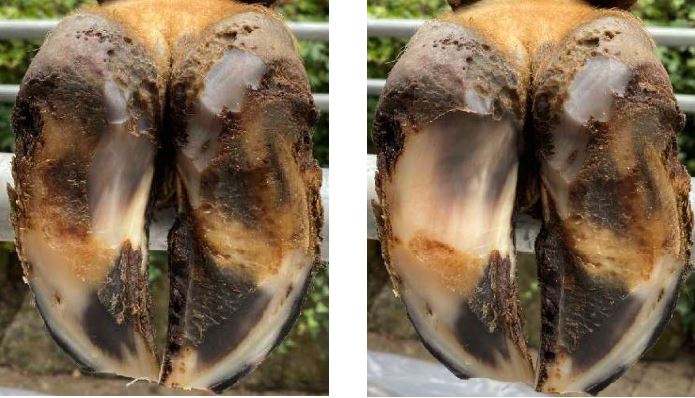 Owen Atkinson
Owen Atkinson
Figure 5a: "Traditional" modelling which extends to the midline on the larger claw (i.e. outer claw for hind feet; inner claw for front feet). The smaller claw (inner claw hind feet) needs very little modelling. The purpose of modelling in the lateral claw is to remove weight from the usual pressure area which develops sole bruising.
Figure 5b: The same foot as shown in Figure 5a, but illustrating the larger model on the outer claw (hind foot).
Some recent studies have shown that a wider and deeper model on the outer claw of the hind foot has benefits to foot health in housed cows. Figure 5b shows the same foot as Figure 5a with this more pronounced modelling area. Figure 3 also shows a deeper and wider model on the outer claw of a hind foot.
Think "foot check" not "foot trim"
Sometimes there may be a risk that people trimming cows’ feet self-congratulate when there is a big pile of white shavings on the floor at the end of the day. Or, as bad, when the bottom of all claws look pristine and white. These are NOT the ways to assess a day’s trimming!
In Figure 3, notice how little horn has been trimmed except at the model sites.
It is important not to follow black marks indiscriminately. Many cows do not need any trimming at all. This is particularly true for grazing herds, where often the cows are walking long distances and, if anything, already have too-thin soles. It can also be true for housed herds where abrasion is high - for example where there is new concrete, or herds bedded on sand cubicles.
Many cows, if requiring a trim at all, only require some modelling, as in Figure 3. Where the toes are becoming long, except for modelling, just conservative trimming is required to correct the toe length and then rebalance the soles, as illustrated in Figures 5a and b.
For these reasons, it is better to think “foot check” rather than “foot trim”. Remember, what has been removed cannot be stuck back on again! Over-trimming is common and it is detrimental to foot health. Be vigilant for it and do not be afraid to call it out when you see it.

